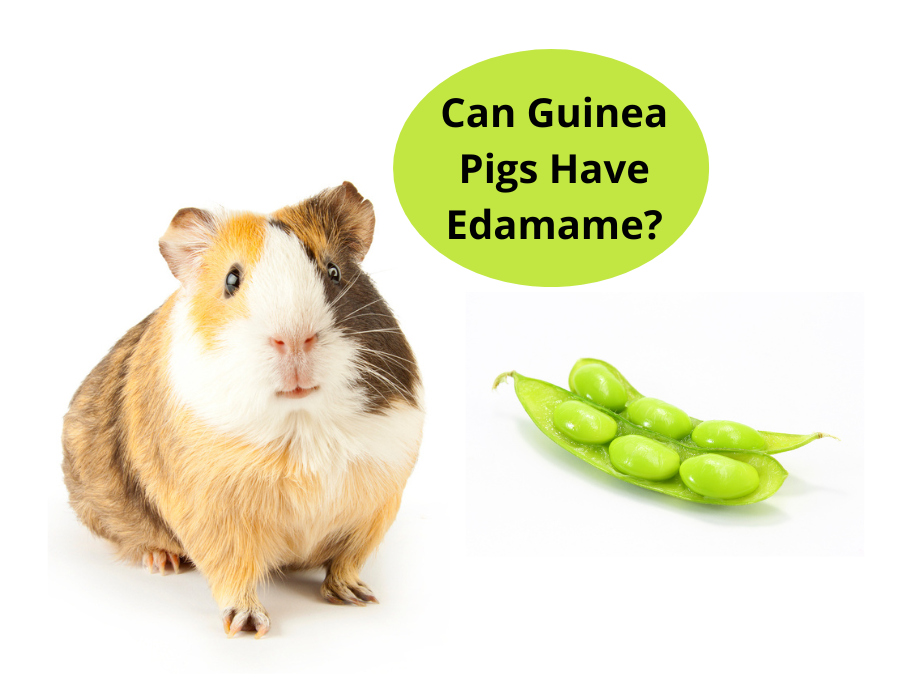Edamame are immature soybeans, still packed within their pods. A common feature of Japanese cuisine, they’re a great, healthy finger food for humans.
But can guinea pigs have edamame, and is it safe for them? Read on to find out!
Can Guinea Pigs Eat Edamame?
Yes, guinea pigs can eat edamame, but only in moderation. Edamame also has to be cooked to be safe for them. Also, preparation must be carefully done, as raw edamame is toxic to guinea pigs.
Nutritional Information For Edamame
One serving of edamame for a guinea pig is a single pod of edamame, which yields about 3 or 4 individual beans, or approximately 2 grams of the food.
The FoodData Central of the US Department of Agriculture lists the following nutritional information for one cooked edamame pod:
- Energy: 2.8 kcal
- Water: 1.42 g
- Carbohydrates: 0.173 g
- Protein: 0.23 g
- Fat: 0.151 g
- Fiber: 0.1 g
- Potassium: 8.44 mg
- Phosphorus: 3.28 mg
- Sodium: 2.56 mg
- Calcium: 1.22 mg
- Magnesium: 1.24 mg
- Lutein and zeaxanthin: 31.4 µg
- Folate: 5.72 µg
- Beta carotene: 3.48 µg
- Vitamin K: 0.564 µg
Benefits Guinea Pigs Can Gain From Eating Edamame
1. High Protein
Edamame is a great source of protein, especially considering that it’s a plant food. It’s packed with essential amino acids. In fact, it has all of them!
This is a great way for a guinea pig to get its fill of these protein components, which helps the health of its organs, tissues, muscles, and general bodily function.
2. High Vitamin Content
Edamame has a lot of vitamins and minerals, especially vitamin K and folate.
These are important for various functions and health factors in a guinea pig’s body, including its eyesight, immunity, and heart health.
3. High Fiber
Fiber is important for digestive health, and there’s a good amount of that in edamame. This, in moderation, can aid in regulating a guinea pig’s bowel movements.
Potential Dangers Of Feeding Edamame To Your Guinea Pig
The biggest danger from edamame is lectin, which is a glycoprotein present in the bean. Raw edamame has an exorbitant amount of lectin, and that toxin is dangerous to guinea pigs.
It’s even dangerous to humans, though, of course, guinea pigs have a much lower tolerance for it.
When consuming lectin, guinea pigs will experience diarrhea, nausea, and vomiting two hours after consumption. This can make them very sick and, in excess, can lead to death.
This is why cooking edamame thoroughly is important before feeding any to a guinea pig.
Another common danger of edamame for guinea pigs is the same negative effect of any new food fed in excess: a guinea pig’s digestive system may be unable to handle it at first.
This is why feeding in moderation and gradually is so important.
How Often Can You Feed Edamame To Your Guinea Pig?
Edamame should be fed in moderation. When calculating nutrition and diet needs, it counts as a vegetable and should fit within a guinea pig’s dietary vegetable allowance.
Juvenile guinea pigs should not be fed edamame; wait until your pet is at an adult age!
Due to the contents of edamame, these beans should be rare treats. Only feed one pod, or three or four beans, of edamame to your guinea pig when you feed it.
As already mentioned, you should not feed this food frequently. Guinea pigs should only eat edamame about once or twice a month.
In addition, be sure to introduce edamame gradually into your guinea pig’s diet. Serve just one bean first and watch for any signs of sickness or digestive upset.
If your guinea pig reacts well, feed two beans next time, then eventually three, and finally four.
Safest Way To Feed Edamame To Your Guinea Pig
The safest way to give your guinea pig edamame is by cooking the edamame first.
Guinea pigs should never be given raw edamame, as there is too much toxic lectin in the raw beans. In addition, edamame should be cooked without salt or any added flavor to avoid causing digestive issues or sickness to guinea pigs.
It’s recommended that you don’t use frozen edamame either. Although you will cook the edamame regardless before serving it, most frozen edamame is pre-salted.
While guinea pigs can eat a little bit of salt, it’s best not to feed them more salt than is strictly a part of a fresh diet. Opt for fresh edamame so you can control what you add to it.
Once you’re done cooking your edamame without any salt or additives for your guinea pig, simply remove the beans from their shell and serve them whole to your pet. If you’re worried about potential choking hazards, you can cut up the edamame first.
You can simply give edamame to a guinea pig as a treat with meals, but it’s also acceptable to mix a safe amount of the beans with pellets or hay. This provides a nice nutritional boost to your guinea pig’s fodder and keeps things interesting for them.
Some guinea pig owners feed their guinea pigs edamame shells, but it’s not recommended to do so. The shells don’t contain anything that’s toxic to guinea pigs, but they’re quite hard and tough and may be hard to chew on. This poses a choking hazard to guinea pigs.
In short, the best way to feed edamame to your guinea pig is to cook the pod without salt, then remove the beans and serve them either whole or chopped.
Edamame should be bright green when served to ensure full, thorough cooking.
Conclusion
Edamame can be a great occasional snack for guinea pigs, fed as a vegetable treat a couple of times a month. Just make sure that you thoroughly cook the edamame before giving it to your guinea pig!

